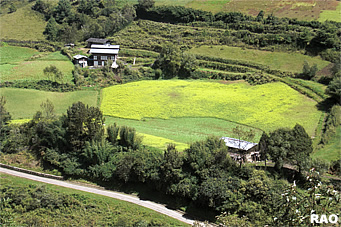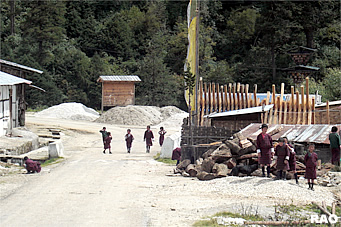 |
Bhutan Development |
|
 |
Bhutan Information |
|
|
 |
|
About
Asian Development Bank (ADB)
|
 |
 |
|
ADB,
based in Manila, is dedicated to reducing poverty in the Asia and Pacific
region through pro-poor sustainable economic growth, social development,
and good governance. Established in 1966, it is owned by 66 members - 47
from the region.
In 2005, it approved loans and grants for projects totaling
$6.95 billion, and technical assistance amounting to $198.8 million.
|
|
Tools
ADB
lends to governments and private enterprises in its developing member countries
(DMCs). Its principal tools are loans and technical assistance, which are
provided to governments for high-priority projects and programs. ADB's
lending supports and promotes investment for development based on a country's
priorities. In 2005, ADB provided loans totaling US$5.8 billion, most of
which went to the public sector. The People's Republic of China was the
largest borrower, followed by Indonesia, Viet Nam, Pakistan,and Bangladesh.
Generating
Resources
Borrowings
from the international capital markets, recycled repayments, and contributions
from members finance ADB's operations. Cofinancing is also important. For
every dollar lent by ADB in 2005, an additional $1.27 cents was mobilized
from other official sources, export credit agencies, and commercial institutions.
Ordinary
Capital Resources. Around three quarters of ADB's lending was from ordinary
capital resources (OCR), which come from capital market borrowings, paid-in
capital provided by members, and accumulated retained income (reserves).
ADB has a triple-A rating and typically raises US$4 billion-US$5 billion
a year from bond issues. OCR loans are made to members with a higher level
of economic development.
In
2001, ADB introduced London interbank offered rate (LIBOR)-based loan products
to meet the needs of its public and private sector borrowers in managing
interest rate and exchange rate risks.
Special
Funds
ADB
also provides loans from its Special Funds resources. The Asian Development
Fund (ADF) is a window for loans on concessional terms to members with
low per capita gross national product and weak debt-repayment capacity.
The ADF is financed by periodic voluntary contributions from donors.
Other
Special Funds include the Technical Assistance Special Fund, Japan Special
Fund, and ADB Institute Special Fund.
Other
Funds
ADB
manages and administers the Japan Scholarship Program Fund, Japan Fund
for Poverty Reduction, and Japan Fund for Information and Communication
Technology (JFICT), and channels financing of grants provided by bilateral
donors to support technical assistance and soft components of loans.
The
JFICT was established in 2001 to harness the potential of information and
communication technology and bridge the digital divide in Asia and the
Pacific. The number of channel financing arrangements rose sharply in 2001,
and included nearly US$50 million in grants from Canada, Denmark, Netherlands,
and United Kingdom.
Technical
Assistance and Grants
Technical
assistance activities - funded through grants and loans - help maximize
development impact. In 2005, 299 technical assistance activities, totaling
US$199 million, were provided for preparing and implementing projects;
supporting advisory activities in areas such as law and policy reforms,
and good governance; and undertaking regional activities.
Private
Sector
ADB
provides direct assistance to private enterprises through equity investments
and loans without government guarantees. In 2005, ADB approved US$753.12
million for 17 private sector loans.
Partners
Although
the DMCs are principally responsible for their economic and social development
and poverty reduction, success depends on the united, sustained efforts
of many partners. ADB works with local and national governments, nongovernment
and community-based organisations and other civil society groups, the private
sector, funding agencies, and other international organisations.
Locations
and Staffing
ADB
headquarters is in Manila. It has 26 field offices around the world, including
19 resident missions in Afghanistan, Azerbaijan, Bangladesh, Cambodia,
People's Republic of China, India, Indonesia, Kazakhstan, Kyrgyz Republic,
Lao People's Democratic Republic, Mongolia, Nepal, Pakistan, Papua New
Guinea, Sri Lanka, Tajikistan, Thailand, Uzbekistan, and Viet Nam; a regional
mission for the South Pacific in Vanuatu as liaison and coordination office
for the Pacific in Australia, and a subregional office for the South Pacific
in the Fiji Islands; a country office in the Philippines; and representative
offices in Europe, Japan, and North America. In addition, ADB has special
office in Timor-Leste, and extended missions in Kerala and Tamil Nadu,
Indonesia and Sumatra, Indonesia.
ADB
has more than 2,000 staff members from over 50 countries.
Members
The
66 members of ADB are the following:
Regional
Afghanistan;
Armenia; Australia; Azerbaijan; Bangladesh; Bhutan; Brunei Darussalam;
Cambodia; People's Republic of China; Cook Islands; Fiji Islands; Hong
Kong, China; India; Indonesia; Japan; Kazakhstan; Kiribati; Republic of
Korea; Kyrgyz Republic; Lao People's Democratic Republic; Malaysia; Maldives;
Marshall Islands; Federated States of Micronesia; Mongolia; Myanmar; Nauru;
Nepal; New Zealand; Pakistan; Palau; Papua New Guinea; Philippines; Samoa;
Singapore; Solomon Islands; Sri Lanka; Taipei,China; Tajikistan; Thailand;
Timor-Leste; Tonga; Turkmenistan; Tuvalu; Uzbekistan; Vanuatu; Viet Nam
Nonregional
Austria;
Belgium; Canada; Denmark; Finland; France; Germany; Ireland; Italy; Luxembourg;
The Netherlands; Norway; Portugal; Spain; Sweden; Switzerland; Turkey;
United Kingdom; United States
| Source:
Asian Development Bank 2006 |
 |
top
|
Videos
|
 |
 |
 |
External
links |
 |
 |
Asian
Development Bank ADB |
|
top
| Information on Bhutan |
 |
| Links |
 |
 |
 |
External
links |
|
|
 |
Asian
Development Bank ADB |
|
|






